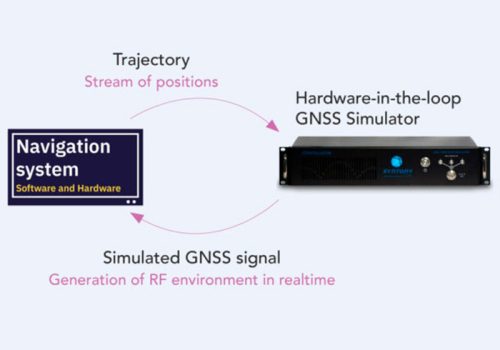Hardware-in-the-loop GNSS testing
- Tech


Share this article !
What is hardware-in-the-loop?
Hardware-in-the-loop is a setup allowing testing in a closed-loop of both the hardware and the software of a navigation system. GNSS RF signals are generated in real-time from a stream of 6 degrees of freedom trajectory input.
The main advantage about hardware-in-the-loop is the ability to test control guidance systems and to define complex user-defined trajectories (phone in hand, tumbling satellite…).
Compared to a real-life outdoor test setup, hardware-in-the-loop simulation allows to check as many times as wanted, how the unit under test performs. It creates a safe and repeatable environment.
Pinpointing and tackling potential design issues early on lead to massive time, budget and effort savings, and this is why it is now an industry standard. The same applies to integration and tests at the system-level. This way of testing allows product development at a much faster pace.
What are the main benefits of hardware-in-the-loop?
- Repeatable: The biggest strength of hardware-in-the-loop test is the ability to run the exact same scenario over and over. This ability is particularly helpful while developing new features or fixing bugs. It can also be used in production.
- Simple: Hardware-in-the-loop can be easy to setup, connecting together a computer, a Constellator™ and a receiver. A real life test on the other hand, involves a lot of staff and logistics. In some environments such as in space, real-life testing is just impossible and hardware-in-the-loop represents a great alternative.
- Cost Efficient: Real life tests are very expensive as it requires moving hardware around the world to test any edge case. While a hardware-in-the-loop test can replace most real-life tests and speed up development, saving money.
- Safe: In real-life test, the hardware is moving in a real electromagnetic environment. In hardware-in-the-loop, the electromagnetic environment is generated around static hardware. Because it is inside a laboratory, there is no risk of losing, damaging equipment or hurting someone.
- Global: Hardware-in-the-loop makes it possible run high-fidelity tests representing any environment anywhere on earth or in space from a laboratory.
Constellator™, the best hardware-in-the-loop GNSS simulation
Historic solutions waste a non-negligible amount of time to process the input trajectory and generating GNSS signal. This used to generate significant latency inducing errors ranging from meters to much more depending on the use-case.
To avoid such impact, Constellator™’s Propagation Engine computes the best estimation of the position at the current simulation time, based on the hardware-in-the-loop data.
Constellator™ does not only achieve zero effective latency, it also ensures the accuracy of the position simulated, even under expected or unpredictable very-high dynamics.
Even if within 1ms, the trajectory faces an unpredicted 5g acceleration, the error in position of the GNSS signals generated would be less than 1 centimeter. For civilian applications, the bias would never be greater than 1mm.
To put things in perspective, it simulates ~100x higher position accuracy than any high-end GNSS receiver.
Constellator™’s hardware-in-the-loop is a plug and play as it will always ensure the GNSS signals are exactly on time and generate the exact trajectory described in input.
There is no need to offset the stream of positions to artificially compensate for delays. Constellator™ provides zero effective latency by default.